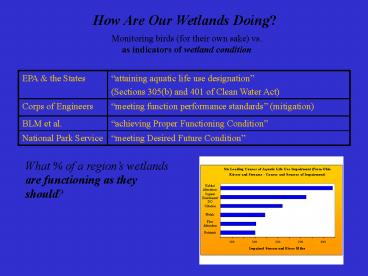Monitoring birds for their own sake vs. - PowerPoint PPT Presentation
1 / 7
Title:
Monitoring birds for their own sake vs.
Description:
Wetlands good for plants aren't always good for birds (& vice versa) ... Going from data to condition which bird metrics work? ... – PowerPoint PPT presentation
Number of Views:32
Avg rating:3.0/5.0
Title: Monitoring birds for their own sake vs.
1
How Are Our Wetlands Doing?
Monitoring birds (for their own sake) vs. as
indicators of wetland condition
What of a regions wetlands are functioning as
they should?
2
Whats Affecting Ability of Wetlands to Support
Birds?
Direct Loss (Filling) Hydrologic
Disruption Contamination Recreation
Invasive Organisms Disease Fragmentation
?
Why dont states routinely monitor wetland
condition? When they do, why arent birds being
used?
3
Strategies for Assessing Regional Wetland
Condition Option 1. Only assess wetland
distribution habitat structure. Option 2. Only
use plant community composition. Option 3. Also
count birds.
4
Option 1. Only assess wetland distribution
habitat structure.
- Can be comprehensive. Methods available,
- e.g., HEP, HGM, ORAM, AREM
- Know structural requirements for most wetland
bird species. - More stable than counts. Reflects potential
capacity. - Cant assess contaminants.
- Hydrologic degradation also hard to detect.
- Structure for which species?
5
Option 2. Only use plant community composition.
- Plants invertebrates might reflect site
conditions better than birds - Less mobile, less area-sensitive.
- Vegetation is fundamentally important to wetland
function. - BUT
- Wetlands good for plants arent always good for
birds ( vice versa) - Managed wetlands arent least-altered
reference but can be productive and necessary. - Birds are more vulnerable to wetland
distribution to some contaminants. - Thus, bird-plant correlations have limited
utility.
6
Option 3. Count birds directly.
- Minimizes some assumptions.
- Proven indicator of fragmentation of forested
some wetland landscapes. - But
- Avian mobility confounds meaningful
interpretation. - How often do wetland birds reflect water
quality?
7
Going from data to condition which bird metrics
work?(Scattered empirical data from PA, OH, VA,
ME, MN, OK, CO, OR, AZ, CA).
Ubiquity-weighted richness, evenness,
density. Percent-similarity to least-altered
reference of same wetland type. Richness, density
(ideally use-days) for Neotropical migrants
(for fragmentation). Low-nesting songbirds (for
urbanization). Regionally declining species
(from BBS data). Peripheral species (for climate
change). For landscape-scale analysis Wading
birds (for hydrologic change, recreation
impacts). Functional guild richness. Ambiguous
Wetland-dependency ratings of species.
How best to represent the disturbance to which we
correlate these? What bird community attributes
do we value?
Dr. Paul Adamus, Oregon State University
adamus7_at_comcast.net































